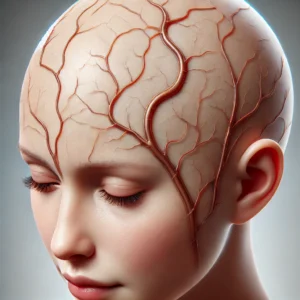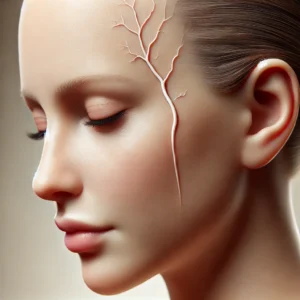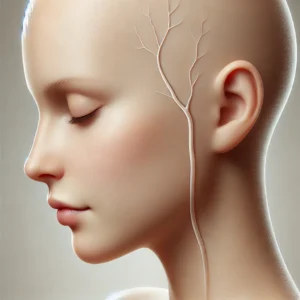Varicose Vein on Your Head

Varicose Veins on Your Head: Causes, Symptoms, and Treatment Options
ntroduction
Varicose veins are typically associated with the legs, but they can also occur in unexpected areas like the head. Although less common, identifying and addressing these veins early can help you maintain optimal health and well-being, ensuring you feel your best every day. Understanding the causes and available treatments can empower you to take proactive steps for your health and well-being.
What Are Varicose Veins?

Varicose veins are swollen, enlarged veins that occur when blood flow is disrupted. Though they typically affect the legs, they can develop anywhere on the body, including the head. These visible veins are usually harmless but can cause discomfort and other symptoms if left untreated.
Can Varicose Veins Form on the Head?
Yes, varicose veins can form on the head, though this is uncommon. This condition may occur due to various factors like trauma, aging, or underlying vascular conditions. Being aware of the causes and risk factors helps you stay informed about your health.
Common Causes of Varicose Veins on the Head
Several factors can contribute to varicose veins developing on the head:
- Trauma or Injury: Head injuries or surgeries may lead to the formation of varicose veins.
- Aging: As we age, veins naturally weaken, making them more susceptible to issues.
- Vascular Conditions: Conditions that affect blood circulation can increase the likelihood of varicose veins.
- Pressure on the Head: Prolonged pressure from activities like wearing helmets or certain sleeping positions can contribute.
Symptoms to Watch For
It’s important to recognize the signs of varicose veins on the head early: Noticeable, enlarged veins on the scalp or forehead. You might experience a subtle throbbing sensation or mild sensitivity in the area. The skin around the veins may show slight changes in color or texture, which can be easily managed with proper care. Any discomfort is usually minimal and only noticeable when touched.
By identifying these symptoms, you can seek appropriate treatment before complications arise.
How Varicose Veins on the Head Are Diagnosed

Getting a proper diagnosis is essential. Medical professionals use several techniques:
- Physical Examination: Doctors will check for visible veins and ask about your symptoms.
- Ultrasound: This non-invasive test shows how well blood is flowing through the veins.
- MRI or CT Scans: These may be used in more severe cases to get a detailed look at the veins and surrounding tissues.
Potential Complications
- Blood Clots: In rare cases, varicose veins can lead to clotting issues.
- Bleeding: If the veins are exposed to trauma, they may bleed. Addressing the condition early helps prevent these issues.
Effective Treatment Options for Varicose Veins on the Head
Fortunately, there are several treatment options available:
- Lifestyle Adjustments: Minor cases may improve with simple changes, such as avoiding prolonged pressure on the head.
- Non-Invasive Treatments: Techniques like sclerotherapy (injecting a solution into the vein) or laser therapy can reduce the appearance of veins.
- Surgical Options: In more severe cases, surgical removal of the veins may be recommended. These procedures are usually safe and effective, with minimal downtime.
How to Prevent Varicose Veins on the Head
Prevention is key when it comes to varicose veins. Some simple ways to reduce your risk include:
- Maintain Healthy Blood Flow: Regular exercise and avoiding prolonged pressure on the head can help.
- Stay Active: Movement promotes better circulation.
- Healthy Diet: A diet rich in antioxidants and anti-inflammatory foods can support vascular health. Being mindful of these habits can help prevent varicose veins from developing.
Real-Life Stories: Managing Varicose Veins on the Head
Hearing from people who have dealt with varicose veins on the head can be comforting. Here are a few personal stories from individuals who have successfully managed their condition. From trying conservative treatments to undergoing procedures, their experiences highlight the importance of early detection and care.
FAQs About Varicose Veins on the Head
- Can varicose veins on the head be harmful?
In most cases, varicose veins are not harmful, but they can cause discomfort. It’s important to consult a healthcare provider for an accurate diagnosis. - Are there natural remedies for varicose veins on the head?
While lifestyle changes can help, professional medical advice is recommended for proper treatment. - How can I tell if I have varicose veins on my head?
Look for visible, swollen veins and consult a healthcare professional if you experience discomfort or any of the symptoms mentioned.
Conclusion: Stay Proactive About Varicose Veins on Your Head
Though varicose veins on the head are rare, understanding the causes, symptoms, and treatments ensures you stay in control of your health. Early intervention can prevent discomfort and complications, so don’t hesitate to consult a healthcare professional if you suspect you may have this condition. With various treatment options available, managing varicose veins is easier than ever, helping you maintain your well-being with confidence.

